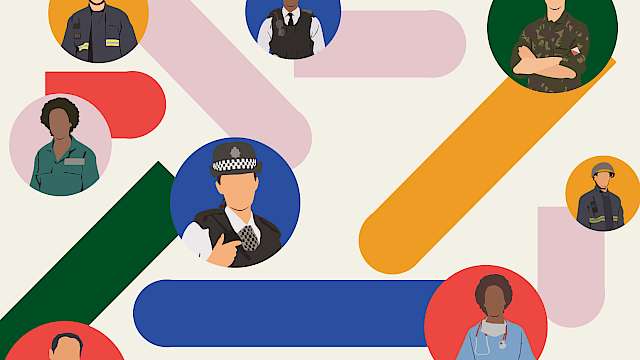All of these resources are available here on our website. We have hyperlinked each resource and included a reference number to help you find and download it. New resources are being published all the time. You can be updated on these new resources by signing up for our newsletter or by following us on social media.
We have organised the catalogue into three parts. The first part groups our resources into four themes: Understanding beliefs and values; Gathering intelligence; Assessing risk; Deterring threats.
These themes are not mutually exclusive and a resource may inform more than one theme. The second part links to all issues of CREST Security Review. The third part lists our resources by project.

Understanding beliefs and values
This theme focuses on understanding the beliefs and values of individuals and groups that present a threat to national security in the UK. It offers an understanding of far-right, Islamic extremism and militant anti-fascism. To further understanding and counter ignorance, it offers guides on various aspects of Islam and British Muslims as well as exploring claims of Sikh radicalisation.
In addition to understanding belief systems, this theme considers how and why ideas are shared. It covers work on disinformation and social media, in part through consideration of Russia. It looks at the use of Russian fake social media accounts, and Russian-speaking foreign fighters in Syria and Iraq. This is supplemented by work on violence promotion in Chan cultures, conspiracy theories, the direct and indirect effects of trauma on radicalisation, and reciprocal radicalisation.
In order to expand our knowledge of violence reduction and disengagement, this theme reports on the internal brakes on violent escalation, and work which seeks to learn lessons from the conflict in Northern Ireland. To enhance policy makers’ knowledge, the theme covers Countering Violent Extremism initiatives, and the effectiveness of existing deradicalisation programmes.

Gathering intelligence
This theme focuses on ways to gather intelligence from, and about, groups and individuals. It covers specific interviewing techniques that help practitioners to elicit accurate information in interview or debrief settings, such as the Timeline Technique, the Cognitive Interview, the Model Statement Technique, the Unexpected Questions Technique and the RING task, which has been specifically designed to support the recall of information about people involved in networks. Relatedly, it considers the importance of rapport building to effective intelligence gathering and illustrates this in both offline and in-person interviews.
To help practitioners make good judgements about where threats to accuracy lie, the theme covers different types of inconsistency and when they matter; what it means when someone says that they ‘don’t know’ or ‘don’t remember‘ something; and techniques that help practitioners to detect deception such as the Verifiability Technique.
As well as looking at effective tools and techniques for eliciting information and assessing its veracity, the theme focuses on individuals carrying out the intelligence gathering. It examines the adaptive behaviour of practitioners in a law enforcement context, and provides an insight into coping under stress in security settings and the effects this can have on performance. Of course, not all intelligence is gathered by interviewing and so the theme considers surveillance in the form of spotting faces and rare targets.
In organisations that gather large amounts of intelligence, technological advances are being used to assist practitioners in their analysis. Here we consider software tools designed to help analysts process large volumes of data quickly and effectively, the role of explanation in systems which use artificial intelligence to help analyse intelligence, and technological advances, such as how to use keystroke dynamics to identify the name and native language of an anonymous user.

Assessing risk
This theme focuses on the assessment of risk to specific people (such as employees), from a wide variety of actors (such as violent extremists) and via a range of techniques (such as disinformation campaigns).
It includes guides and reports on assessing risk of violence from groups and individuals such as Islamic extremists and far-right groups. We also have reports that enable a more nuanced understanding of risk of violence such as research on the internal brakes on violent escalation, research on trauma, adversity and engagement in violent extremism, understanding how terrorists and criminals make decisions, how countering violent extremism interventions apply to women, and the relationship between mental health and terrorism.
In this theme we also include guides on technology enabled risk such as phishing attacks, the Internet of Things and risks from the spread of disinformation. Examples draw on Russia and disinformation, focusing on the Caucasus, Ukraine, and the annexation of Crimea, to illustrate this.
The theme looks at assessing risk to employees, including workshops that focused on performance and coping under stress, as well as understanding moral injury and trauma in child exploitation investigators.
From the opposite angle, other work explores the risk from employees, and we include a series of reports on organisational change and insider threat, as well as research on the cyber security risks of digital hoarding behaviour.

Deterring threats
This theme is broad in scope, addressing our need to better understand how we can deter threat and protect ourselves.
It addresses deterring threat from terrorism through examination of how criminals and terrorists make decisions, and reports on interventions that prevent and counter extremism. This includes interventions that offer promise in disrupting groups through Telegram, and those that consider effective management of terrorism-related offenders in prison.
It looks at public experiences of counter terrorism measures in the UK and overseas; reports on how members of the public can help deter threat by reporting suspicious behaviour; and how to inoculate against the spread of disinformation.
The theme also considers how security professionals can communicate better with employees about how to protect organisations; understanding and mitigating the risk of large-scale change to counterproductive workplace behaviour; and how to best protect staff from phishing attacks in order to mitigate cyber threats.
The innovative tools outlined in the imaginative scenario planning toolkit enables policy makers to consider future threat and how to deter it.
Copyright Information
As part of CREST’s commitment to open access research, this text is available under a Creative Commons BY-NC-SA 4.0 licence. Please refer to our Copyright page for full details.
IMAGE CREDITS: Copyright ©2024 R. Stevens / CREST (CC BY-SA 4.0)


